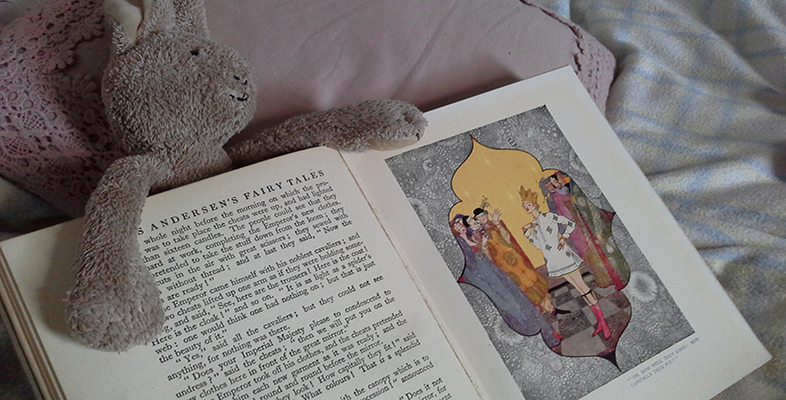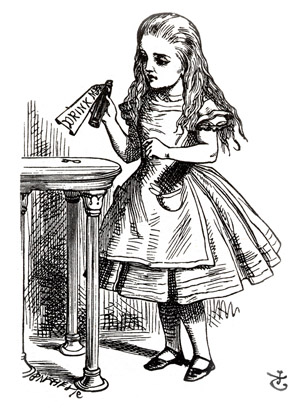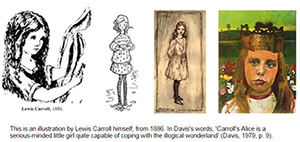6 Illustration as interpretation: the example of Alice
Another way that illustrations can play an important part in a text is by providing a specific interpretation of elements of the verbal narrative.
The illustration below is by John Tenniel, the illustrator for the original editions of Alice’s Adventures in Wonderland and Through the Looking-glass. For many people, this has become the classic image of Alice. If you are familiar with the books containing Tenniel’s illustrations, this may well be the image you have in your mind’s eye when you think of Alice.
But this is just one particular illustrator’s interpretation of the character, and some people feel that it does not represent the character created by Lewis Carroll’s narrative. For example, in the words of one commentator, Tenniel’s drawings make Alice look ‘overly serious and expressionless’ (Davis, 1979, p. 6).
Activity 8
Click on the link to view four more illustrations of Alice, and then pass the mouse over each illustration to reveal details about its illustrator. In what ways do you feel that these artists have interpreted Alice’s character differently from Tenniel?
Discussion
The images show different interpretations of Alice by four illustrators: Lewis Carroll, Mabel Lucie Attwell, Arthur Rackham and Peter Blake.
The first illustration is by Lewis Carroll. It is a black-and-white drawing of a young girl with long dark wavy hair. Only her upper body is depicted. She is facing front-right, and is wearing a top with short sleeves and a v-neck. She is shown pushing aside a curtain with her left hand as she looks at a key that she is holding up in front of her in her right hand. The caption just below the illustration says, ‘Lewis Carroll, 1886’. When the mouse cursor is held over the image, it enlarges slightly and text appears saying, ‘This is an illustration by Lewis Carroll himself, from 1886. In Davis’s words, “Carroll’s Alice is a serious-minded little girl quite capable of coping with the illogical wonderland” (Davis, 1979, page 9)’.
The second illustration is a black-and-white line drawing by Mabel Lucie Attwell. She portrays Alice as a tall, slender, slightly awkward young girl, with shoulder-length fair hair and long thin legs. She is shown standing, facing frontwards, and holding a fan open in front of her with both hands. She is wearing a short polka-dot puffball of a dress, cinched in at the hips and with oversize sleeves, and dark stockings and white buckled shoes. When the mouse cursor is held over the image, it enlarges slightly and text appears saying, ‘This is an illustration by Mabel Lucie Attwell, from 1910. Attwell was a very popular illustrator in the 1920s and 30s, and was known for her rather cute and nostalgic depictions of children, of which Alice is an example’.
The third illustration of Alice is by Arthur Rackham. Again, Alice is shown as a tall, slender girl. She is standing with her arms behind her back, her body turned towards the right, although her face is looking frontwards, at the viewer. She has long dark hair and rosy cheeks. She is wearing a long-sleeved, full-skirted dress with a pattern of flowers on it, and dark stockings and shoes. The colours in the illustration are very subtle, reminiscent of a charcoal drawing on beige paper with highlights of red chalk. In the top left corner is the word ‘Alice’, while Rackham’s signature and the date are in the bottom left corner. When the mouse cursor is held over the image, it enlarges slightly and text appears saying, ‘Arthur Rackham’s Alice is considered by some to be “maturer” than Tenniel’s (Davis, 1979, page 11). Again there is a seriousness of character to her, which is quite different from the stylised, almost cartoon-quality of Atwell’s interpretation’.
The fourth image is of a watercolour painting by Peter Blake. The colours are clear and vivid, and Alice is portrayed as a modern little girl with long straight brown hair, brown eyes and freckles. Only her head and shoulders are depicted, and she is looking directly out at the viewer, with a serious expression. She is wearing a white top with a red trim bordering the neckline and the top of the sleeves. On her head is what looks like a gold paper crown. Directly behind her is a mass of red, white, pink and yellow flowers, and beyond them are green fields and, in the distance, the outline of green hills. When the mouse cursor is held over the image, it enlarges slightly and text appears saying, ‘Peter Blake, who is most famous for his pop art, created a series of watercolours based on the Alice books in 1970. These have more of a realist element to them than the other illustrations, and show a pensive young girl’.


